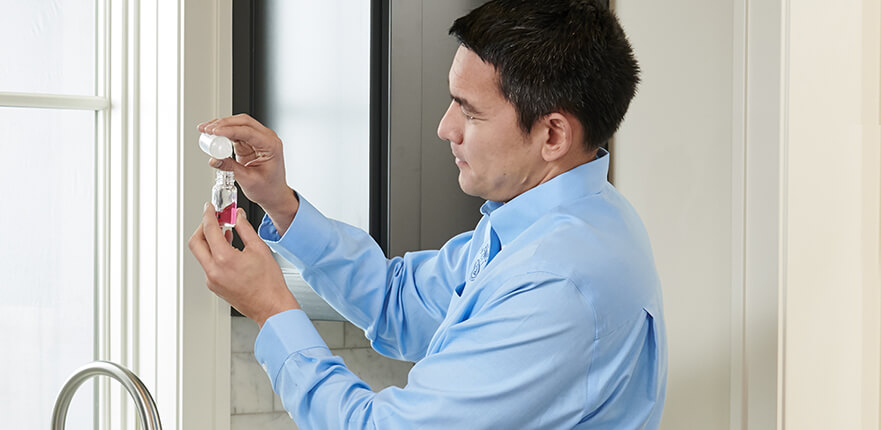In the world of appliances, water softeners are wonderfully low-key. With the exception of initially entering your water hardness level, any regeneration timing parameters and refilling the salt, they just hum along and do their job. Although low-maintenance, there are a few easy ways you can make them work more efficiently and last longer.
Maintaining Your Water Softener
For efficient, long-lasting relief from hard water, follow the recommendations below. Need professional support? EcoWater can provide an in-home diagnosis to determine what your problem is and optimize your water treatment system to address your needs in no time.
Avoid salt bridges and salt mushing
A salt bridge occurs when a hard crust forms in the brine tank and creates an empty space between the water and the salt, preventing the salt from dissolving into the water to make brine. Without the brine, the resin beads that soften your water can’t do their job. Common causes of bridging include high humidity, temperature changes around the water softener or using the wrong kind of salt. You may have a salt bridge if your salt tank appears full but you know your water isn’t soft. The quickest way to test for a salt bridge is to take a broom handle and carefully push on the top of the salt, using a little bit of pressure to break it up if it has solidified.
Salt mushing is the more serious of the two problems and happens when dissolved salt recrystallizes and forms a sludge on the bottom of the brine tank. This thick layer of salt keeps the water softener from properly cycling through the regeneration process, leaving your water hard and creating a serious blockage in the tank. If you test for a salt bridge but it doesn’t break up when pushing on it, salt mushing is probably the cause. Draining the softener of its water, digging out all the old salt and replacing it with fresh salt is the only way to fix this problem.
To avoid these salt snafus, opt for high-quality salt pellets, which greatly reduce the potential for any problems—especially salt mushing. Additionally, don’t overfill your brine tank with salt. Keeping it half-full prevents older salt from sticking to the walls of the tank. Finally, it’s important to manage the humidity level around your water softener. If it’s too humid, condensation can occur in the brine tank, causing the salt to bond together and bridge.
Be selective with your salt choice
There are three basic types of water softener salt:
- Rock
- Solar
- Evaporated
Rock salt is the least expensive, as it contains higher levels of insoluble minerals or impurities. Over time, this can result in a muddy tank, decreasing the softening efficiency while leaving impurities in your water. Solar salt, which is much more soluble than rock salt, is obtained by the evaporation of seawater and is found in both pellet and crystal form. The best option is evaporated salt, which is obtained through a combination of mining and evaporation. This is the purest form of salt at 99.99% sodium chloride.
In general, use higher-purity salts, which will leave less storage tank residue, lowering the likelihood of salt bridges and salt mushing, and will result in less maintenance. High-quality salts—and salts in pellet form—help eliminate bridging problems. Additionally, many leading brands also offer salt products that address specific issues, such as high iron concentration, rust stains and sodium alternatives.
Resin bead cleaner
Even though your resin beads are routinely recharged by salt, it doesn’t hurt to flush the resin bed every few months with a water softener cleaner to keep it in top form. Over time, a water softener can become polluted with iron, silt, heavy metals and other organic compounds that cause your softener to lose its efficiency. To reduce the incidence of ineffective resin, simply pour the manufacturer’s recommended amount of water softener cleaner down the brine well and regenerate the system manually. The cleaner is then discharged during the normal flushing process of the water softening cycle. This action keeps the resin “clean” and able to absorb as much calcium and magnesium as possible throughout its lifespan.
Clean the venturi valve
The venturi and nozzle create the suction to move brine from the brine tank into the resin tank during the regeneration cycle. Because of this, the venturi valve sometimes gets plugged with sand, sediment and dirt, so a clean valve is imperative for the water softener to work properly. Simply unscrew the valve cover (don’t worry, there are no special tools required) and remove the internal parts, giving them all a good cleaning in soapy water. This process should be done twice a year to keep the water softening process smooth and efficient.
EcoWater Can Do the Work for You
By periodically checking your water softener and completing basic maintenance, you’ll keep it running smoothly for longer. Have questions or want professionals to take care of your water softener for you? Locate your closest EcoWater dealer to schedule your free, in-home consultation.

Contact Your Local EcoWater Dealer
EcoWater has hundreds of authorized dealers. Find your local dealer, who has licensed and trained Water Pros ready to solve your water problems with accurate diagnosis and treatment.
